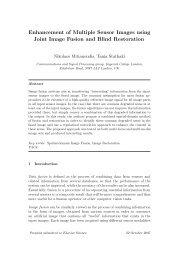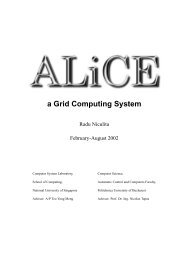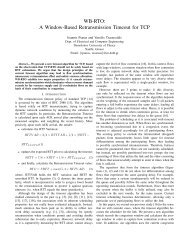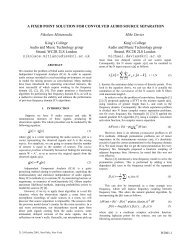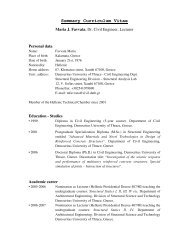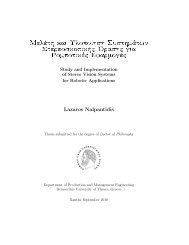RESEARCH ON AD HOC NETWORKING: CURRENT ... - Utopia
RESEARCH ON AD HOC NETWORKING: CURRENT ... - Utopia
RESEARCH ON AD HOC NETWORKING: CURRENT ... - Utopia
Create successful ePaper yourself
Turn your PDF publications into a flip-book with our unique Google optimized e-Paper software.
Abstract<br />
<strong>RESEARCH</strong> <strong>ON</strong> <strong>AD</strong> <strong>HOC</strong> <strong>NETWORKING</strong>: <strong>CURRENT</strong><br />
ACTIVITY AND FUTURE DIRECTI<strong>ON</strong>S<br />
Aleksi Penttinen<br />
Networking Laboratory, Helsinki University of Technology, P.O.Box 3000<br />
FIN-02015 HUT, Finland<br />
This article is a survey on the current status and direction<br />
of research on ad hoc networking. We categorize the ongoing<br />
research and outline the major challenges which have<br />
to be solved before widespread deployment of the technology<br />
is possible. The views presented by Perkins in [1]<br />
are used as a premise, which is then complemented with<br />
discussion and references to the latest publications.<br />
1 Introduction<br />
Ad hoc networks (AHNs) are wireless multi-hop packet<br />
networks without any fixed infrastructure. An AHN network<br />
is formed solely by its terminals so that each terminal<br />
connected to the network provides also relaying service<br />
for others, i.e. acts as a router. Advantages of such<br />
system are rapid deployment, robustness, flexibility and<br />
inherent support for mobility.<br />
AHN can work as a stand-alone autonomous network<br />
providing internal connections for a group. Demand for<br />
such networks could arise in the contexts of shared desktop<br />
meeting, disaster recovery, or in various military applications.<br />
However, no commercial “killer applications”<br />
are known for this technology yet.<br />
In the future, ad hoc networks probably form the outermost<br />
region of the internetwork, where a wired backbone<br />
connects both the fixed local area networks and the<br />
mobile (both the fixed infrastructure and the ad hoc) networks.<br />
Whereas the base stations of a fixed infrastructure<br />
networks are directly connected to the core, an AHN is<br />
typically connected through a satellite link or a terrestrial<br />
switch (fixed wired connection point, or mobile radio<br />
link). This vision, however, requires still some further<br />
developments in ad hoc networking.<br />
Basic research and potential applications of ad hoc networks<br />
are evolving together, spurring each other into further<br />
achievements. The need for an application can give<br />
directions for the research and, on the other hand, the research<br />
enables new applications to be created. Although<br />
this network concept has been originally considered in the<br />
context of packet radio networks [2] earlier, it has become<br />
very popular again during the past few years. The work<br />
is going on within the IETF’s MANET working group [3]<br />
for standards and the research is very active throughout<br />
the world.<br />
Currently the most fundamental research issue in ad hoc<br />
networking, between the physical layer and the application<br />
layer, is packet routing. In fixed infrastructure mobile<br />
networks routing is, for the most part, an engineering<br />
problem (implementation of hand-overs etc.), whereas in<br />
ad hoc networks it is essentially theoretical. The problems<br />
and their solutions considering packet routing are<br />
closely related to those widely studied in the case of ordinary<br />
fixed networks, but also completely new fundamental<br />
challenges have emerged due to the peculiar features<br />
of AHNs, such as:<br />
• Dynamic network topology and structure<br />
– Nodes may join or leave the network<br />
– Some or all nodes may be mobile<br />
• Limited bandwidth<br />
• Constrained power<br />
• Broadcast nature of transmission<br />
In this paper, we discuss the on-going research efforts<br />
to tackle the problems between the present day and the vision<br />
of practical ad hoc networking solutions. We survey<br />
the current work in progress in the field and also anticipate<br />
some of the next steps the research is taking. The leading<br />
theme is the intellectual challenge posed by this new technology.<br />
Therefore, we select the important issues which<br />
are to be solved in order to enable widespread ad hoc network<br />
deployment and concentrate on very general level<br />
instead of protocol specific details. In other words, algorithms<br />
and ideas are preferred to implementations. Emphasis<br />
is on the topics that are not discussed otherwise in<br />
this seminar.<br />
The “new world” of AHN technology has been visited<br />
by now, there is no such thing that completely unexplored<br />
territories in this field. Active research has produced a<br />
wide range of proposals, but so far not many problems are<br />
solved. We start from the issues recognized in [1], with a<br />
few additions, and describe their recent development with
the latest pointers to selected literature. Subjectivity cannot<br />
be avoided in this sort of study, so the reader is pleaded<br />
to be gentle in his or her criticism.<br />
The area is developing at the pace of several hundreds<br />
of publications yearly and the speed unavoidably outdates<br />
any summaries, conclusions and predictions in very<br />
short time. It is clear that ad hoc networking is in its<br />
infancy what comes to its research and further development<br />
are being expected for years to come. Hence, previous<br />
works considering the future research in this field<br />
have been very few in number. In addition to [1] these issues<br />
are treated in [4], and in [5] the wireless networks<br />
research was considered in general. From the application<br />
point of view, another notable instance relevant the topic<br />
is the Wireless World Research Forum (WWRF) [6], a<br />
forum founded by several leading telecom corporations.<br />
Their Book of Vision attempts to recognize future research<br />
strategies in all wireless communications.<br />
The organization of the rest of this paper is as follows.<br />
In Section 2 we analyze publishing activity in 2001 to get<br />
a picture on the key topics. Section 3 goes down to the details<br />
of open research issues, starting from the ideas in [1]<br />
and discussing the current development in each of the areas<br />
as well as the questions that are still lacking any kind<br />
of resolution. In Section 4 we briefly go through two large<br />
scale projects that are going on as examples of comprehensive<br />
studies to bring AHNs into existence before concluding<br />
with some futuristic visions in Section 5.<br />
2 Research status<br />
This section attempts to summarize the current research<br />
that is being conducted on ad hoc networks. Due to the<br />
vast amount of the material about the topic, we chose to<br />
take a representative sample of the most recent research<br />
results and to categorize them to get a rough overview on<br />
the situation. For this purpose we will look into the publishing<br />
activity of the IEEE (publications are available at<br />
[7]).<br />
2.1 Overview<br />
The classification, shown in Table (1) and Figure (1),<br />
was done for all the ad hoc networking related publications,<br />
conference and journal articles without distinguishing<br />
them, published within the IEEE organization in 2001.<br />
Categories were selected so that they would describe their<br />
contents unambiguously, but still provide detailed and informative<br />
knowledge on large scale (i.e the number of<br />
classes was tried to keep as small as possible). Poweraware<br />
protocols were counted twice, once into the Powerawareness<br />
category and once into the corresponding category<br />
in where the protocol or algorithm was considered.<br />
For example, a publication with the topic “A power-aware<br />
routing protocol” would be counted into both Routing and<br />
1 Routing 73<br />
2 MAC, scheduling 22<br />
3 Special AHNs 18<br />
-Bluetooth (8)<br />
4 Applications 15<br />
-Multimedia (6)<br />
5 Clustering, organization 11<br />
6 Technology, physical layer 9<br />
7 General overviews 9<br />
8 Internet Protocols on AHNs 8<br />
9 Network management 7<br />
10 QoS, service differentiation 7<br />
11 New network concepts 5<br />
12 Service Availability 5<br />
13 Positioning, situation awareness 5<br />
14 Topology studies 4<br />
15 Practical studies 2<br />
16 Transport issues 2<br />
17 Security 2<br />
18 Mobility 1<br />
19 Cooperation 1<br />
Power-awareness 22<br />
Table 1: Publications on ad hoc networks within IEEE during<br />
2001, see Figure 1 for illustration<br />
3<br />
2<br />
4<br />
5<br />
6 7 8<br />
1<br />
15<br />
16<br />
17 18 19<br />
9 1011121314<br />
Figure 1: Publications on ad hoc networks within IEEE<br />
during 2001, see Table 1 for key
Power-awareness categories.<br />
Four clear facts can be immediately extracted from the<br />
data:<br />
• Routing protocols are being studied extensively<br />
• Overall volume of the research effort on AHNs is<br />
high (>200 publications a year just in this organization!)<br />
• The spectrum of the topics is wide; ad hoc networking<br />
has brought together protocol engineers and<br />
mathematicians<br />
• Based on the status of the research projects conducting<br />
this work, further rapid development is to be expected<br />
at all fronts during the next few years.<br />
2.2 Remarks on the categorization<br />
Care should be taken when interpreting the categorization<br />
in detail. Although the major directions are visible,<br />
the sample is by no means exhaustive or unbiased, special<br />
issues of magazines may have highlighted some topics<br />
more than deserved. Furthermore, the classification of papers<br />
has some inaccuracies. Compromises were unavoidable<br />
because each paper was counted only in one category<br />
(with the exception of power-awareness) despite the fact<br />
that its contents may have been suitable for another class<br />
as well.<br />
3 Open questions<br />
As we saw in the previous section, ad hoc networking has<br />
been a popular field of study during the last few years.<br />
Almost every aspect of the network has been explored in<br />
some level of detail. Yet, no ultimate resolution to any of<br />
the problems is found or, at least, agreed on. On the contrary,<br />
more questions have arisen than been answered.<br />
This section outlines the major problems remaining to<br />
be solved. The protocol dependent development possibilities<br />
are mostly omitted and the focus is on the “big picture”,<br />
on the problems that stand in a way of having peerto-peer<br />
connectivity everywhere in the future. The topics<br />
are:<br />
• Scalability<br />
• Quality of Service<br />
• Client server model shift<br />
• Security<br />
• Interoperation with the Internet<br />
• Power control<br />
• Node cooperation<br />
• Support for different routing protocols<br />
• Interoperation with other wireless networks<br />
• Aggregation<br />
This survey here summarizes and complements the approach<br />
presented by Perkins [1], with a few additions<br />
and several updates. The discussion attempts to sketch the<br />
following aspects for the topics: motivation, novel ideas<br />
since the publication of [1], and the still remaining problems<br />
and their relative importance.<br />
3.1 Scalability<br />
Most of the visionaries depicting applications which are<br />
anticipated to benefit from the ad hoc networking technology<br />
take scalability as granted. Imagine, for example,<br />
the vision of ubiquitous computing where the networks<br />
can grow to thousands of nodes. How can be the swarm<br />
of control messages carried out in this dynamic environment?<br />
It is unclear how large an ad hoc network can actually<br />
grow.<br />
Ad hoc networks suffer, by nature, from the scalability<br />
problems in capacity. For a rough idea about this, we may<br />
look into simple interference studies. In a non-cooperative<br />
network, where omni-directional antennas are being used,<br />
the throughput per node decreases at a rate 1/ √ N,where<br />
N is the number of nodes [8]. That is, in a network with<br />
100 nodes, a single device gets approximately one tenth<br />
of the theoretical data rate of the network interface card at<br />
maximum. This problem, however, cannot be fixed except<br />
by physical layer improvements, such as smart antennas.<br />
If the available capacity sets some limits for communications,<br />
so do the protocols as well. Route acquisition,<br />
service location and encryption key exchange are just examples<br />
of tasks that will require considerable overhead,<br />
which will grow rapidly with the network size. If the<br />
scarce resources are wasted with profuse control traffic,<br />
it is clear that ad hoc networks will see never dawn in<br />
practice. Scalability is an important research topic for the<br />
future, not only because of its necessity for ad hoc networks,<br />
but also because of the applicability of same ideas<br />
in the Internet.<br />
In the protocol design itself, several issues have to<br />
be considered with the potential applications in mind.<br />
Whereas proactive routing is not scalable in a dynamic environment<br />
as such, on-demand protocols allow deploying<br />
large networks in the expense of increased route acquisition<br />
latency. The minimum route acquisition latency is<br />
the product of maximum network diameter and minimum<br />
node traversal time for route requests. Correspondingly,<br />
demands for short latencies for route acquisition limit the<br />
network size drastically. Can this be accepted by the applications?<br />
If not, what can be done?<br />
Traditional way of scaling the network has been hierarchical<br />
routing, the running of routing and other net-
works functions on a several hierarchical levels. Hierarchies<br />
can be constructed by clustering algorithms which<br />
collect nodes near each other into groups. While hierarchy<br />
may not be natural for all ad hoc networks, it is<br />
one of the very few methods capable of providing any<br />
relief to the scalability problem. Mobility and dynamic<br />
hierarchy, however, need to be carefully taken into account<br />
in order to achieve any practical solutions. Several<br />
clustering solutions have already been brought forward<br />
recently, e.g. [9, 10]. Some other approaches have proposed<br />
also wide-area routing protocols [11] to complement<br />
broadcast-intensive local routing. Development of<br />
simple rules to cluster nodes and share routing information<br />
will remain actively researched.<br />
Routing simulations discussed in the literature have<br />
been very small in comparison of the futuristic idea of<br />
ubiquitous computing or sensor dust of tens of thousands<br />
of nodes. Therefore, large scale simulation studies and<br />
also trial deployment are essential to study in the future.<br />
Future research will probably develop scenarios, isolate<br />
useful applications, to optimize the trade-off between capacity<br />
and scalability in each case separately. For a general<br />
solution much remains to be done. Without development<br />
in intelligent antennas and multiuser detection, scaling<br />
AHNs to thousands of nodes seems a daunting task<br />
indeed.<br />
3.2 Quality of Service<br />
The heterogeneity of existing applications in the Internet<br />
have challenged the network which is able to provide only<br />
best-effort service. Voice, live video and file transfer, to<br />
mention the common examples, all have very differing requirements<br />
what comes to delay, jitter, bandwidth, packet<br />
loss probability etc. Quality of Service (QoS) is being developed<br />
to meet the emerging requirements. QoS is a guarantee<br />
by the network to provide certain performance for<br />
a flow in terms of the quantities mentioned above. QoS<br />
routing attempts to locate routes that satisfy given performance<br />
constraints and then reserve enough capacity for<br />
the flow.<br />
If we consider ad hoc networks as a natural extension<br />
of the Internet at the borders where direct connections<br />
to fixed infrastructure are unavailable, these applications<br />
(voice, live video, file transfer etc.) will exist also in ad<br />
hoc networks and so there will also be naturally a demand<br />
for QoS. However, the lack of fixed infrastructure in ad<br />
hoc networks makes the QoS appear even more challenging<br />
problem than ever before. Bandwidth is seriously limited,<br />
routes are using links with differing quality and stability.<br />
Links are often asymmetrical so that, for example,<br />
QoS for telephony (2-way traffic with QoS-demands) may<br />
not be achieved by just one route. These facts are often<br />
completely ignored by the routing protocols, although the<br />
link-state algorithms could be used to find suitable routes<br />
if the links are given suitable QoS costs. Alternatively, on-<br />
Figure 2: Services can be difficult to locate in ad hoc networks<br />
demand protocols can be configured to return only communications<br />
paths that comply with the desired parameters.<br />
QoS in AHNs is still largely unexplored area, a good introduction<br />
to the field of study can be found from [12]. Issues<br />
of QoS robustness, QoS routing policies, algorithms<br />
and protocols with multiple, including preemptive, priorities<br />
are to be researched in the future. It seems that in ad<br />
hoc networks end user may have to “haggle” with the network<br />
on the QoS parameters as high quality is frequently<br />
not available.<br />
Quality of service cannot be guaranteed for a long time<br />
because of the link quality variations due to the interferences<br />
etc. Methods to detect and report changes in<br />
the connection quality should be investigated in the future.<br />
Perkins suggest an addition of a new ICMP message<br />
(QOS LOST) to be defined to inform the endpoints that a<br />
new route discovery should be initiated.<br />
3.3 Client-server model shift and service location<br />
In the Internet, a network client is typically configured to<br />
use a server as its partner for network transactions. These<br />
servers can be found automatically or by static configuration.<br />
In ad hoc networks, however, the network structure<br />
cannot be defined by collecting IP-addresses into subnets.<br />
There may not be servers, but the demand for basic<br />
services still exists. Address allocation, name resolution,<br />
authentication and the service location itself are just examples<br />
of the very basic services which are needed but<br />
their location in the network is unknown and possibly even<br />
changing over time. Where do services reside (see Figure<br />
(2)? Who is administering or maintaining the these services?<br />
In ad hoc some recent proposals have considered in-
tegrating route discovery and service location tasks by<br />
allowing only particular kind of services to react to the<br />
broadcast requests. This approach, however, can be seen<br />
to have the following deficiencies:<br />
• Inserting application service discovery into a network<br />
layer protocol violates the modular protocol design.<br />
• The client may not be able to specify the required<br />
service in a way that the request can be carried on<br />
the network layer.<br />
• Authorization can be difficult at the network layer.<br />
Other possibilities are, e.g., using well-known multicast<br />
addresses for very basic features, such as DNS. Also protocols<br />
for service location have been proposed. Some recent<br />
works on this field include [13, 14].<br />
An intellectual challenge related to the service availability<br />
problems is the design of distributed network functions.<br />
It could be investigated whether and which services<br />
(or their locations) could be shared or circulated among<br />
nodes? Still the question of who is administering and ultimately<br />
responsible for the services remain unanswered.<br />
3.4 Security<br />
Ad hoc networks are particularly prone to malicious behavior.<br />
Lack of any centralized network management or<br />
certification authority makes these dynamically changing<br />
wireless structures very vulnerable to infiltration, eavesdropping,<br />
interference etc. Security is often considered to<br />
be the major “roadblock” in commercial application of ad<br />
hoc network technology [15].<br />
Security requirements depend naturally on the application<br />
where they are needed. In cases where all the terminals<br />
are “on the same side”, such as military or emergency<br />
rescue applications, it is enough to get protection<br />
against outside interference. In civilian, especially commercial,<br />
applications even mere lack of cooperation may<br />
be enough to bring the network on its knees. The nodes<br />
enter and leave the networks as they wish and links may<br />
be using nodes that should not have access to data. How<br />
to define membership in ad hoc networks, how to classify<br />
nodes to the trusted and the not-trusted ones?<br />
Traditional methods of protecting the data with cryptographic<br />
methods face a challenging task of key distribution<br />
and refresh. Accordingly, the research efforts on security<br />
have mostly concentrated on secure data forwarding.<br />
However, many security risks are related to the peculiar<br />
features of ad hoc networks. The most serious problem<br />
is probably the risk of a node being captured and compromised.<br />
This node would then have access to structural<br />
information on the network, relayed data, but it can also<br />
send false routing information which would paralyze the<br />
entire network very quickly.<br />
In [16] the authors discussed the security problems in<br />
general and proposed a self-organized public-key infrastructure<br />
for ad hoc network cryptography. Key exchanging,<br />
however, raise again the scalability issues. Furthermore,<br />
defining keys for multicast transmission seems even<br />
tougher challenge.<br />
Secure routing was considered in [17], which had an<br />
appealing idea of dividing the data on N pieces which are<br />
send along separate routes and, at the destination, the original<br />
message is reconstructed out of any (M − out − of −<br />
N) pieces of the message.<br />
Security is indeed one of the most difficult problems to<br />
be solved, but it has received only modest attention so far.<br />
The “golden age” of this research field can be expected to<br />
dawn only after the functional problems on the underlying<br />
layers have been agreed on.<br />
3.5 Interoperation with the Internet<br />
It seems very likely that one of the most common applications<br />
of ad hoc networks require a connection to the Internet.<br />
By ad hoc network technology the coverage of wireless<br />
LAN systems can be expanded and complemented.<br />
However, the issue of defining the interface between the<br />
two very different networks is not straightforward.<br />
If a node in ad hoc network has an Internet connection,<br />
it could offer Internet connectivity to the other nodes. The<br />
node could defined itself as a default router and the whole<br />
ad hoc network could be considered to be “single-hop”<br />
from the Internet perspective although the connections are<br />
physically over several hop links. Recently a practical solution<br />
for this problem was suggested in [18]. The idea<br />
was to combine the Mobile-IP technology with ad hoc<br />
routing [18] so that the gateway node can be considered<br />
to be foreign agent for Mobile IP.<br />
3.6 Power control<br />
Power-aware networks are currently being extremely popular<br />
within the ad hoc networking research. The motivation<br />
for power-aware thinking for wireless communications<br />
is obvious, as summarized in [19]:<br />
• Functional utility – New features and functionality<br />
usually costs additional energy. By increasing energy<br />
efficiency, devices may meet new user demands without<br />
reduced useful lifetime.<br />
• Size and weight – Increased power efficiency can allow<br />
smaller and lighter power source.<br />
• Maintenance – Power sources will always need to be<br />
replaced or recharged at some point, and the cost for<br />
this can vary from inconvenient to prohibitive.<br />
• Environmental – Battery designs contain acids and<br />
heavy metals, which must be disposed of properly.
There are two research topics which are partially similar:<br />
the maximization of lifetime of a single battery and<br />
the maximization of the lifetime of the whole network.<br />
The former is related to commercial applications and node<br />
cooperation issues whereas the latter is especially of military<br />
etc. interest, where the node cooperation is already<br />
assumed.<br />
The goals can be achieved either by developing better<br />
batteries, or by making the network terminals’ operation<br />
more power efficient. The first approach is likely to<br />
give a 40% increase in battery life in near future (with Li-<br />
Polymer batteries) [19]. As to the device power consumption,<br />
the primary aspect are achieving energy savings is<br />
through the low power hardware development using techniques<br />
such as variable clock speed CPUs, flash memory,<br />
and disk spindown [20]. However, from the networking<br />
point of view our interest naturally focuses on the device’s<br />
network interface, which is often the single largest consumerofpower.<br />
Energy efficiency at the network interface can be improved<br />
by developing transmission/reception technologies<br />
on the physical layer and by sensing inactivity on the application<br />
layer, but especially with certain networking algorithms;<br />
MAC, routing and handling of end-to-end connections.<br />
In all these approaches, savings are based on intelligently<br />
turning off the interface when it is not needed.<br />
Medium Access Control - protocols can be made<br />
power-aware by simple rules: when the node has nothing<br />
to send or receive, or it overhears a transmission (i.e. the<br />
radio channel is busy) it can power off the network interface<br />
and wake again after a while to see is there anything<br />
to do. This has significant advantages as receiving unnecessary<br />
data is surprisingly expensive in terms of energy<br />
consumption. One such protocol, PAMAS, is introduced<br />
in [21], for which the authors reported up to 70% energy<br />
savings.<br />
Just above the MAC-layer reside different topology reduction<br />
algorithms. Their premise is that if the network<br />
is dense enough, only a subset of nodes is required to be<br />
relaying nodes to maintain full connectivity. This means<br />
that some of the nodes can be put to a sleep state (such<br />
as provided by IEEE 802.11 [22]) only to wake up periodically<br />
to see whether there are incoming traffic directly<br />
to them. Active nodes form a forwarding backbone in the<br />
network, which can be found distributedly as discussed in<br />
[23]. This problem is closely related to (minimum) dominating<br />
set problem in graph theory.<br />
In routing, one usually tries to maximize the network<br />
lifetime. In other words, routes are selected by their transmission<br />
energy cost giving the priority to the nodes with<br />
full batteries. This way the time to network partition can<br />
be maximized distributedly [24]. Furthermore, unicast and<br />
multicast routing should be considered separately when<br />
considering energy-efficiency due to the broadcast nature<br />
of the transmission [25].<br />
Protocol Layers<br />
Transport layer<br />
Network layer<br />
Tx<br />
MAC layer<br />
- retransmission policies<br />
- congestion control<br />
- avoiding transmission<br />
- avoiding weak nodes<br />
- sleep patterns; reduced topology<br />
- avoiding overhearing<br />
Receive Idle Sleep<br />
Network Interface State<br />
Figure 3: Energy saving methods on protocol layers and<br />
between transmitter states<br />
On transport level, collisions and retransmissions<br />
should be avoided at all cost. Traditional TCP is badly<br />
suited for wireless interfaces as it cannot separate packet<br />
losses due to congestion and due to transmission errors,<br />
which can be common. An experimental transport protocol<br />
for wireless networks is the Wave and Wait protocol<br />
[26].<br />
Radio interface of a network device can have four different<br />
states (while powered on): transmit, receive, idle,<br />
and sleep. The energy consumption of these is highest for<br />
transmission and lowest for sleep mode. Figure (3) shows<br />
a summary of the energy saving methods as well as the<br />
transmitter states between which the corresponding savings<br />
are obtained.<br />
Power-aware techniques will remain an important research<br />
area in near future on all aspects described above.<br />
How these can be combined with the conflicting QoS demands?<br />
How can we make sure that a node cannot give<br />
false information on its power level just to avoid relaying?<br />
Heuristic rerouting to maximize the network lifetime?<br />
3.7 Node cooperation<br />
Closely related to the security issues, the node cooperation<br />
stands in the way of commercial application of the technology.<br />
The fundamental question is: Why should anyone<br />
relay others’ data? The answer is simple: to receive the<br />
corresponding service from the others. However, when<br />
differences in amount and priority of the data are existing,<br />
the situation is more complex. Surely, a critical fire<br />
alarm box should not waste its batteries for relaying gaming<br />
data, nor should it denied access because of this behavior.<br />
Encouraging nodes to cooperate may lead to the introduction<br />
of billing in ad hoc networks, with a similar idea<br />
which was suggested for Internet congestion control in
[27]. Well-behaving network members could be rewarded<br />
for the relaying and selfish or malicious users could be<br />
charged. Implementation of any kind of billing mechanism,<br />
however, is very challenging. These issues are still<br />
wide open.<br />
These questions have been recently introduced in e.g.<br />
[28], where a simple mechanism based on a counter in<br />
each node is studied.<br />
3.8 Support for different routing protocols<br />
If energy costs or other dynamic quantities are to be<br />
tracked, there may be significant differences between routing<br />
algorithm performances. For certain sensor networks,<br />
static node-state based algorithms enable route optimization<br />
especially in multicast case, whereas such algorithm<br />
would be too cumbersome for networks with mobility.<br />
Dozens of routing protocols have bee introduced, all<br />
of which typically perform well in some situations while<br />
having significant weaknesses in other cases. Question is,<br />
can the heterogeneity of the ad hoc networks be covered<br />
by any single routing algorithm?<br />
If no all-round routing protocol can be found or agreed<br />
on, the networks have to be capable of supporting several<br />
protocols. This can happen so that as a certain number<br />
of network nodes detect that their routing is not optimal<br />
the network switches to another protocol. When a protocol<br />
ceases to be optimal and how can the change be implemented?<br />
Another option is that the network is able to simultaneously<br />
support several routing methods. How to define the<br />
interfaces and self-awareness?<br />
3.9 Interoperation with other wireless networks<br />
3.9.1 Ad hoc networks<br />
The self-organization of ad hoc networks is a challenge<br />
when two independently emerged networks collide. This<br />
is an unexplored research topic that has implications on<br />
all levels on the system design.<br />
What happens when two autonomous ad hoc networks<br />
move into same area? Surely they are unable to avoid interfering<br />
each other. Ideally, the networks would recognize<br />
the situation and be merged. However, the issue of<br />
joining two networks is not trivial; the networks may be<br />
using different synchronization, or even medium access or<br />
routing protocols. Security becomes also a major concern<br />
in these cases. Can the networks adapt to the situation?<br />
A common example; a military unit moving into an area<br />
covered by a sensor network could be such a situation;<br />
moving unit would probably be using different routing<br />
protocol with location information support, while the sensor<br />
network would have a simple static routing protocol.<br />
A similar problem arises when a device is powered on<br />
at a border of several networks and it has to choose which<br />
one to join.<br />
3.9.2 Anytime, anywhere<br />
One of the most important aims of the research on all<br />
wireless networks is to provide seamless integration of all<br />
types of networks. This issue raises questions how can the<br />
ad hoc networks designed so that they are compatible with<br />
e.g. WLAN or 3rd Generation cellular networks? Could<br />
the other networks extended from last-hop to multi-hop<br />
wireless connections using these techniques?<br />
3.10 Aggregation<br />
Finally, there is the question of rationalizing and collecting<br />
the research results. Research has been extremely active<br />
during the past few years. The pace has been so fast<br />
that the big picture is somewhat blurred. That is why there<br />
is a need for summarizing research efforts to combine,<br />
not just compare, different approaches. The trend is towards<br />
more complete ad hoc networking solutions instead<br />
of specific protocols in the near future. The first works on<br />
this field has been conducted for energy conserving purposes<br />
because of its inherent “multilayer”-structure that<br />
provides a natural environment for combining different<br />
ideas.<br />
There is work to be done to find best possible combinations<br />
of MAC, topology reduction, and routing protocols.<br />
There is also work to be done in combining preferable<br />
properties of different protocols. This will naturally lead<br />
to discussion on specific networks, application tailored solutions,<br />
as the ultimate ad hoc networking solution is still<br />
far away, if it even can be found.<br />
4 Major ongoing efforts<br />
In this section we discuss two very different but comprehensive<br />
examples of recent ongoing long term research<br />
projects aiming at producing functional ad hoc networks.<br />
4.1 The Terminodes project<br />
The Terminodes project [29] is a 10-year joint effort of<br />
seven Swiss research institutes started in 2000. Their aim<br />
is to study and prototype a large-scale ad hoc network<br />
with the emphasis on the self-organization feature. The<br />
network has a two-layer routing system which is based<br />
on location information at long ranges while routing traditionally<br />
over few hops. Other issues considered so far<br />
in this project have been mobility management, GPS-free<br />
positioning, cooperation and security.<br />
The project had goals also on higher level of abstraction<br />
than just the network design. It is meant to be an intellectual<br />
stimulus to find new research challenges, e.g. “how
Figure 4: Small sensors using ad hoc radio [30]<br />
do we define a formal model for fair exchange?” [11]. Ultimately<br />
the project is a societal vision in which this kind<br />
of communication is considered.<br />
4.2 Smart Dust<br />
Maybe the most concrete project related to ad hoc networks<br />
is DARPA-funded Smart Dust [30] at the University<br />
of California, Berkeley. Smart Dust goals are to<br />
design, build and test networks consisting of small sensor<br />
nodes (see Figure (4)). The applications include various<br />
military purposes, such as battlefield sensor networks,<br />
traffic mapping, sensor mine fields, etc. In civilian use<br />
these devices can be used e.g. building sensors in earthquake<br />
zones. The sensors communicate with RF or optical<br />
transmitters and the communications issues (which are<br />
not the main theme in the project) raise some interesting<br />
questions, see [31].<br />
5 Future view<br />
It is sometimes useful to try to predict the future to get<br />
new ideas and see the present day in a more appropriate<br />
context on larger scale. Future is unknown, but it is, after<br />
all, the result of the actions we take now. In this Section we<br />
look into the crystal ball and give scenarios on the future<br />
development. How do ad hoc networks evolve? What are<br />
the enabling technologies? What kind of applications we<br />
are going to see in the near future?<br />
5.1 Going Ad Hoc<br />
There are many open questions related to ad hoc networks<br />
applications. Before a public demand for any set of applications<br />
can be found, these networks will be deployed<br />
in various specialized cases. In the first phase, which can<br />
be already foreseen we will have autonomous military and<br />
public authority ad hoc networks, which can be used for<br />
a very specific purposes. For the most part the networks<br />
will be quite small except for the sensor applications, including<br />
the millimeter sized sensing networks.<br />
In the second phase, the future cellular infrastructure<br />
extensions could be implemented so that ad hoc networking<br />
would act as a basis of the whole 4th generation<br />
wireless technology. An image of completely unrestricted<br />
“anytime, anywhere” communications using this technology<br />
seems, however, to belong to the more distant future.<br />
Problems with security, authorization and management<br />
are daunting indeed in large scale networks. Hence,<br />
it is more likely that the technology will be used to augment<br />
wireless LAN technology with the limited network<br />
size or hops in connections.<br />
5.2 The Revolution?<br />
Assume that most of the problems discussed in this paper<br />
are solved and there is a possibility to deploy secure<br />
broadband self-organizing ad hoc networks with hundreds<br />
or thousands of nodes. What will happen?<br />
The general trend is towards low-level infrastructure<br />
and increased end-user responsibility. Being able to freely<br />
communicate transfer information with close-by people<br />
is, of course, convenient, but it may even have larger societal<br />
effects.<br />
On a larger scale, ad hoc networking can very well be<br />
the next revolution in the world of communications. It enables<br />
local communities to manages their own need for<br />
connectivity using their own local resources. The control<br />
of the local network will be hence again where it belongs<br />
and the ISP era might be coming to an turning point. Why<br />
to a call a taxi if you are visiting your next door neighbor<br />
or the shop around the corner? The telecommunications<br />
business would experience shift from the operators<br />
towards both device manufacturers and end-users themselves.<br />
Are the operators going to allow this development?<br />
Can it be done without their support?<br />
In this local community networking view can be the<br />
seed of a completely new approach to communicating<br />
with people and henceforth to understanding what it<br />
means to be a part of a community. In these local networks<br />
many services, such as local web pages, e-mail and telephony,<br />
would be free from charge and jurisdiction by remote<br />
administrations. Naturally, there would be some privacy<br />
concerns in the beginning, but trust inside the community<br />
should provide the necessary umbrella for the privacy.<br />
Ad hoc networks have indeed the potential to change<br />
how we see the communications world today. For alternative<br />
scenarios of the wireless future, where the services<br />
stay centralized, interested reader should consult e.g. [32].
5.3 Conclusion<br />
Whereas ad hoc networks will become widely used in military<br />
contexts in near future, the corporate world has to<br />
continue the daunting search for profitable commercial<br />
applications and possibilities of the technology. Meanwhile,<br />
the academic community has adopted the new field<br />
as a playground to apply their ideas to create something<br />
completely new. In all, although the widespread deployment<br />
of ad hoc networks is still years away, the research<br />
in this field will continue being very active and imaginative.<br />
References<br />
[1] Charles E. Perkins (Ed.). Ad Hoc Networking.<br />
Addison-Wesley, December 2000.<br />
[2] John Jubin and Janet D. Tornow. The DARPA packet<br />
radio network protocol. Proc. of IEEE, 75(1):21–32,<br />
1987.<br />
[3] IETF. Mobile ad hoc networks working<br />
group. http://www.ietf.org/html.charters/manetcharter.html.<br />
[4] C.-K. Toh. Ad Hoc Mobile Wireless Networks: Protocols<br />
and Systems. Prentice Hall, December 2001.<br />
[5] Magnus Frodigh, Stefan Parkvall, Christian Roobol,<br />
Per Johansson, and Peter Larsson. Future-generation<br />
wireless networks. IEEE Personal Communications,<br />
pages 10–17, October 2001.<br />
[6] Wireless World Research Forum. The book<br />
of visions 2001. http://www.wireless-worldresearch.org/,<br />
December 2001.<br />
[7] IEEE. IEEE/IEE electronic library.<br />
http://ieeexplore.ieee.org.<br />
[8] Piyush Gupta and P. R. Kumar. The capacity of wireless<br />
networks. IEEE Transactions on Information<br />
Theory, 46(2):388–404, March 2000.<br />
[9] S. Basagni. Distributed clustering for ad hoc networks.<br />
In Proceedings of the 1999 International<br />
Symposium on Parallel Architectures, Algorithms,<br />
and Networks (I-SPAN’99), pages 310–315, June<br />
1999.<br />
[10] P. Basu, N. Khan, and T.D.C. Little. A mobility<br />
based metric for clustering in mobile ad hoc networks.<br />
In Proceedings of Distributed Computing<br />
Systems Workshop 2001, pages 413–418, 2001.<br />
[11] Ljubica Blazevic, Levente Buttyan, Srdjan Capkun,<br />
Silvia Giordano, Jean-Pierre Hubaux, and Jean-Yves<br />
Le Boudec. Self-organization in mobile ad-hoc networks:<br />
the approach of terminodes. IEEE Communications<br />
Magazine, pages 166–174, June 2001.<br />
[12] Satyabrata Chakrabarti and Amitabh Mishra. Qos<br />
issues in ad hoc wireless networks. IEEE Communications<br />
Magazine, 39(2):142–148, February 2001.<br />
[13] L.M. Feeney, B. Ahlgren, and A. Westerlund. Spontaneous<br />
networking: an application oriented approach<br />
to ad hoc networking. IEEE Communications<br />
Magazine, 39(6):176–181, June 2001.<br />
[14] H. Koubaa and E. Fleury. A fully distributed mediator<br />
based service location protocol in ad hoc<br />
networks. In Proc. of Global Telecommunications<br />
Conference (GLOBECOM), 2001, volume 5, pages<br />
2949–2953. IEEE, 2001.<br />
[15] Zygmunt J. Haas, Jing Deng, Ben Liang, Panagiotis<br />
Papadimitatos, and S. Sajama. Wireless ad hoc<br />
networks. In John Proakis, editor, Encyclopedia of<br />
Telecommunications (to appear). John Wiley, December<br />
2002.<br />
[16] Jean-Pierre Hubaux, Levente Buttyan, and Srdjan<br />
Capkun. The quest for security in mobile ad hoc<br />
networks. Proc. of Mobi<strong>HOC</strong> 2001, pages 146–155,<br />
October 2001.<br />
[17] P. Papadimitratos and Z.J. Haas. Secure routing<br />
for mobile ad hoc networks. In SCS Communication<br />
Networks and Distributed Systems Modeling<br />
and Simulation Conference (CNDS 2002), SanAntonio,<br />
TX, January 2002.<br />
[18] Yuan Sun, Elizabeth M. Belding-Royer, and<br />
Charles E. Perkins. Internet connectivity for ad hoc<br />
mobile networks. International Journal of Wireless<br />
Information Networks, special issue on Mobile Ad<br />
hoc Networks (to appear), 2002.<br />
[19] Chiara Petrioli, Ramesh R. Rao, and Jason Redi.<br />
Guest editorial: Energy conserving protocols. ACM<br />
Mobile Networks and Applications, 6(3):207–209,<br />
June 2001.<br />
[20] Christine E. Jones, Krishna M. Sivalingam, Prathima<br />
Agrawal, and Jyh Cheng Chen. A survey of energy<br />
efficient network protocols for wireless networks.<br />
Wireless Networks, 7(4):343–358, September 2001.<br />
[21] Suresh Singh and C. Raghavendra. Pamas: Power<br />
aware multi-access protocol with signalling for ad<br />
hoc networks. ACM SIGCOMM Computer Communication<br />
Review, 28(3):5–26, July 1998.<br />
[22] IEEE Computer Society LAN MAN Standards<br />
Committee. Wireless LAN medium access control<br />
and physical layer specifications, IEEE 802.11 standard,<br />
August 1999.
[23] Benjie Chen, Kyle Jamieson, Hari Balakrishnan, and<br />
Robert Morris. Span: an energy-efficient coordination<br />
algorithm for topology maintenance in ad hoc<br />
wireless networks. ACM Wireless Networks Journal<br />
(to appear), 8(5), September 2002.<br />
[24] Jae-Hwan Chang and Leandros Tassiulas. Energy<br />
conserving routing in wireless ad-hoc networks. In<br />
INFOCOM, volume 1, pages 22–31, 2000.<br />
[25] J.E. Wieselthier, G.D. Nguyen, and A. Ephremides.<br />
Algorithms for energy-efficient multicasting in ad<br />
hoc wireless networks. In Military Communications<br />
Conference Proceedings, 1999. IEEE MIL-<br />
COM 1999., volume 2, pages 1414–1418, 1999.<br />
[26] V. Tsaoussidis, A. Lahanas, and H. Badr. Wave &<br />
wait protocol (wwp): low energy, high throughput<br />
for mobile ip-devices. In Proc. of IC<strong>ON</strong> 2000, 2000.<br />
[27] Jeffrey K. MacKie-Mason and Hal R. Varian. Pricing<br />
the internet. In B. Kahin and J. Keller, editors,<br />
Public Access to the Internet. Prentice-Hall, New<br />
Jersey, 1994.<br />
[28] L. Buttyan and J. P. Hubaux. Stimulating cooperation<br />
in self-organizing mobile ad hoc networks.<br />
Technical Report DSC/2001/046, EPFL-DI-<br />
ICA, August 2001.<br />
[29] http://www.terminodes.org.<br />
[30] http://robotics.eecs.berkeley.edu/ pister/SmartDust/.<br />
[31] J. Kahn, R.H. Katz, and K. Pister. Emerging challenges:<br />
Mobile networking for smart dust. J. Comm.<br />
Networks, pages 188–196, September 2000.<br />
[32] Aurelian Bria, Fredrik Gessler, Olav Queseth,<br />
Rickard Stridh, Matthias Unbehaun, Jiang Wu, and<br />
Jens Zander. 4th-Generation wireless infrastructures:<br />
Scenarios and research challenges. IEEE<br />
Personal Communications, pages 25–31, December<br />
2001.



